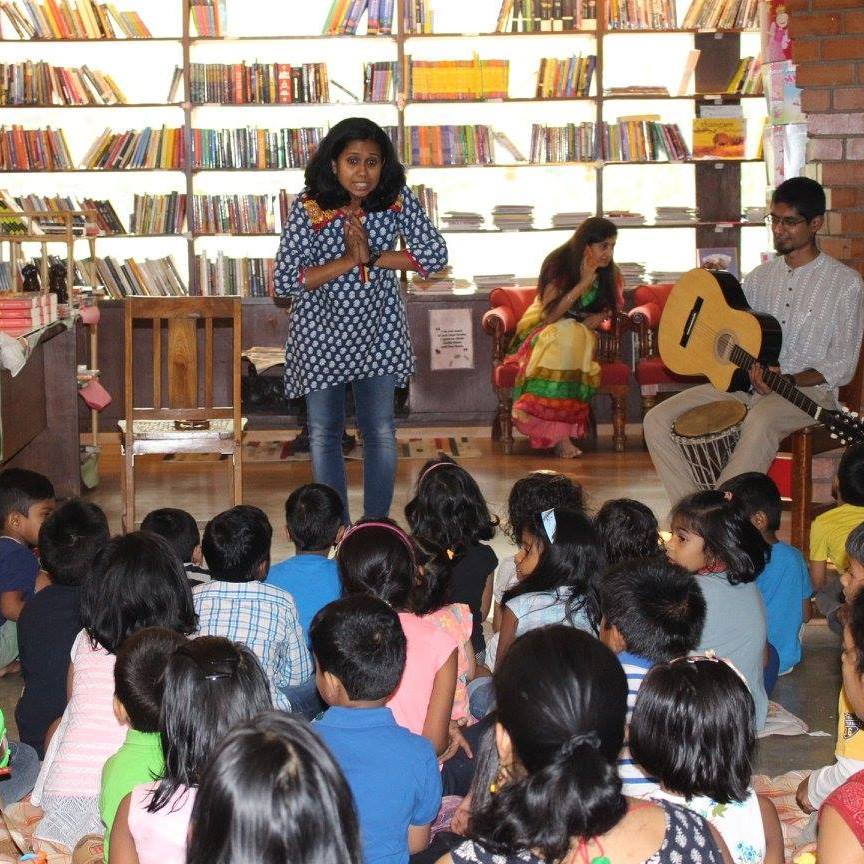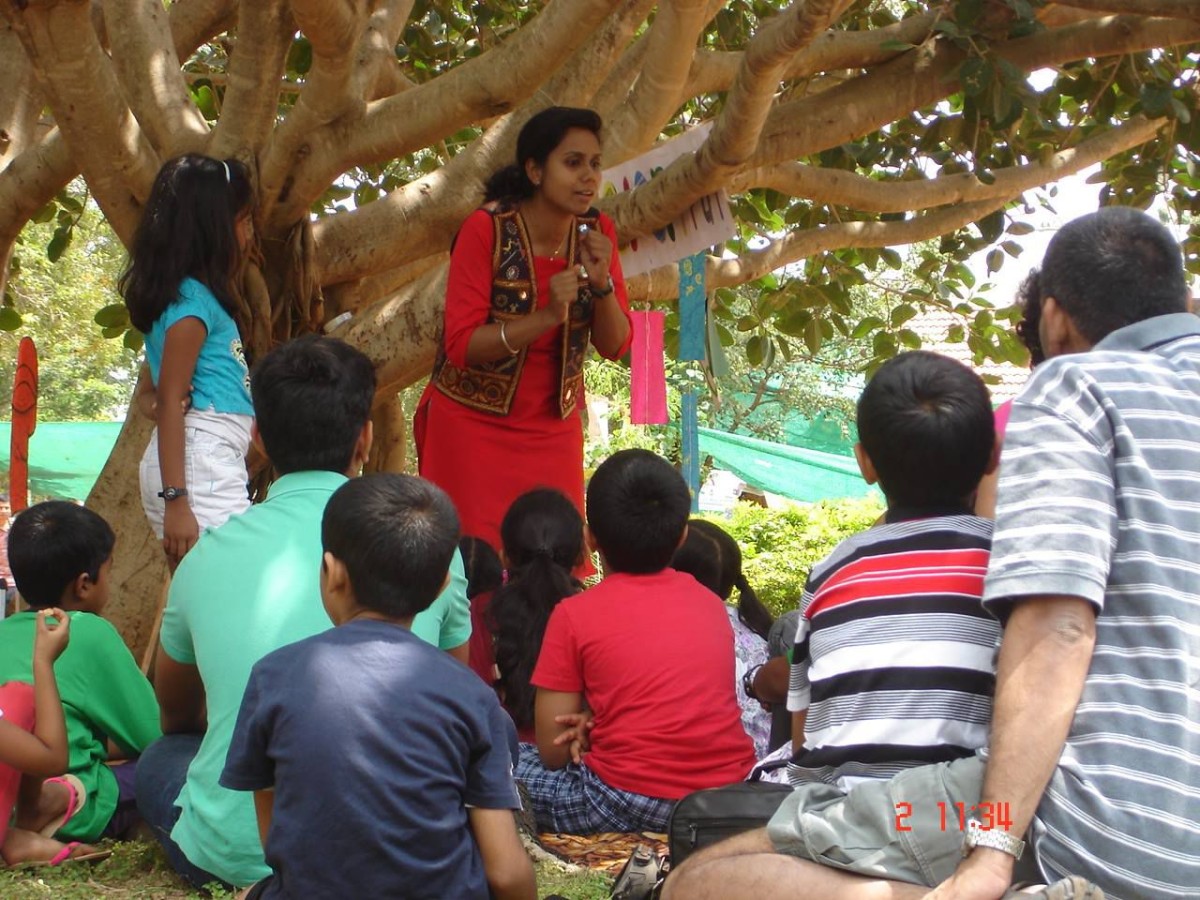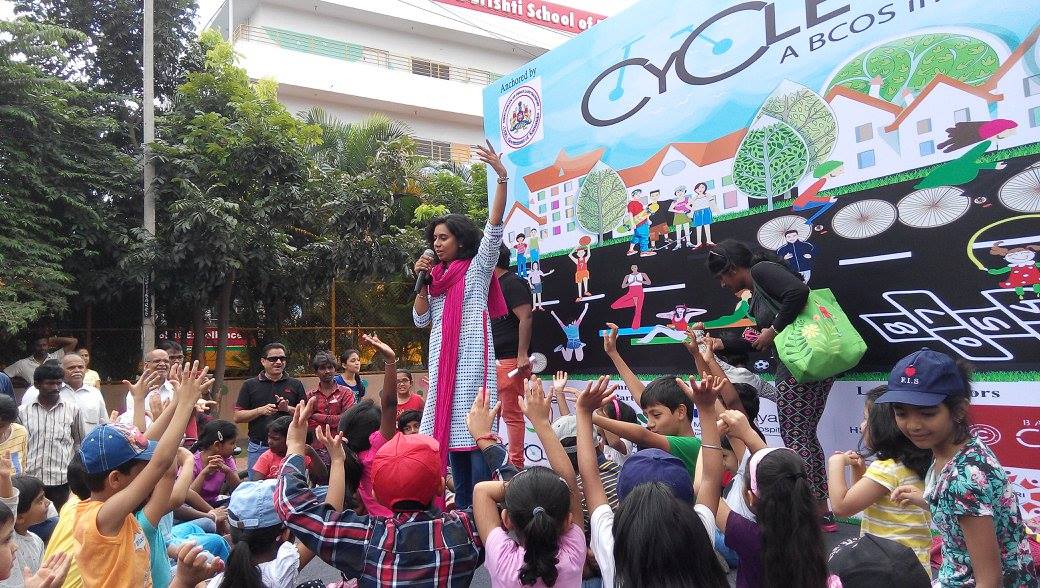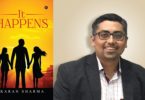At Tell-A-Tale, we celebrate stories and storytellers, and today on Earth Day, we are celebrating a storyteller who is passionate about nature, sustainable living and environment, and is working actively to promote a greener way of life. How? Through stories of course! Meet Priya Muthukumar of Storipur.
We chatted with her about her journey as a storyteller and the beginning of Storipur. Read on…
Thank you for speaking with us. What defines Priya – the storyteller?
Priya is someone who believes strongly that we are all connected, everything in the universe is actually speaking. Sometimes, we fail to notice those connections; that’s when we need subtle reminders to revive them, reminders that come through stories. As a storyteller, Priya loves to connect the dots through stories old and new and every time she does that she realizes that there are many more connections to be made (just as Steve Jobs once said – “You can’t connect the dots looking forward; you can only connect them looking backwards. So you have to trust that the dots will somehow connect in your future.”). The environment – Mother Nature and communities hold a very special place in the stories she shares. She is a learner who is learning and sharing through stories .
Tell us about the story of Storipur. What motivated you to start Storipur?
Writing my resume has always been my biggest challenge. Simply because I’ve dabbled with 5 to 6 professions, from pharmaceuticals to the electronic media, so consolidation of everything would leave me perplexed! As a young stay-at-home  mother, the school which my kid went to wanted me to fill in as their Nursery teacher. Well, that got things rolling for me. 7 years in the school brought the learner in me, back to life. Reading about different methodologies in education, attending and later conducting workshops I realized, I belonged to the education sector, my true calling. With the growing need to explore more, I quit my job as the Nursery Coordinator. I prepared modules on how to incorporate Environmental and Social responsibilities as part of the curriculum. There weren’t many takers. Working for a year as an educational consultant for a popular newspaper, I conducted workshops in many schools in Bangalore. Several ‘aha’ moments and all of them reinforced one thing – stories are powerful tools for learning. One day, getting back from school, I started creating stories for all the topics – waste segregation, plastic consumption etc. Independence Day was around the corner and some of us in our apartment were planning for the celebrations. An idea struck me (pretty much like a lightening) and it changed everything for me. I decided to conduct a storytelling session on our terrace for our apartment kids. My husband and daughter were the wind beneath the wings for this idea. They made a poster, we circulated it in the neighborhood…and with lots of love and support from my family and friends, Storipur was born. It’s going to be three years and Storipur is an evolving venture which has partnered with several groups and organizations sharing stories of different kinds on several topics , sometimes ,for a cause and sometimes for just fun, but, three words will remain very special to Storipur – Nature, sustainability and communities.
mother, the school which my kid went to wanted me to fill in as their Nursery teacher. Well, that got things rolling for me. 7 years in the school brought the learner in me, back to life. Reading about different methodologies in education, attending and later conducting workshops I realized, I belonged to the education sector, my true calling. With the growing need to explore more, I quit my job as the Nursery Coordinator. I prepared modules on how to incorporate Environmental and Social responsibilities as part of the curriculum. There weren’t many takers. Working for a year as an educational consultant for a popular newspaper, I conducted workshops in many schools in Bangalore. Several ‘aha’ moments and all of them reinforced one thing – stories are powerful tools for learning. One day, getting back from school, I started creating stories for all the topics – waste segregation, plastic consumption etc. Independence Day was around the corner and some of us in our apartment were planning for the celebrations. An idea struck me (pretty much like a lightening) and it changed everything for me. I decided to conduct a storytelling session on our terrace for our apartment kids. My husband and daughter were the wind beneath the wings for this idea. They made a poster, we circulated it in the neighborhood…and with lots of love and support from my family and friends, Storipur was born. It’s going to be three years and Storipur is an evolving venture which has partnered with several groups and organizations sharing stories of different kinds on several topics , sometimes ,for a cause and sometimes for just fun, but, three words will remain very special to Storipur – Nature, sustainability and communities.
What influenced you to become a storyteller?
Honestly, I never ever dreamt that one day, I’d be a storyteller. The impact created, the discussions that followed and the creativity triggered when I told stories to the children in my class and the kids in the family were the biggest motivation for me to take up storytelling as a profession.
[color-box color=” customcolorpicker=” rounded=false dropshadow=false]I remember, a kid, all of 6 years, telling me that he hated Jack in ‘The Jack and the Beanstalk’ story, because Jack stole things from the giant! Perspective-building and questioning, I love this part about storytelling.[/color-box]
How have the stories in your life influenced your style of storytelling and the way you use stories?
As a kid, I remember my grandmother telling stories. Generally, they were mythological stories, or stories of her struggle and challenges she faced. And of course, stories told by my convent Sisters during my school assembly. I think these  story experiences have influenced my story-journey a lot. I remember my grandmother used to wander with the narrative in her story. There were several open ends in the story which had to be filled with answers from the listener (me), like, ‘what would you have done?’, ‘Have you felt different like that, anytime?’. Today, I try and use a similar format to trigger critical and abstract thinking amongst listeners. I remember, a kid, all of 6 years, telling me that he hated Jack in ‘The Jack and the Beanstalk’ story, because Jack stole things from the giant! Perspective-building and questioning, I love this part about storytelling. I try and avoid words like ‘good’,’ bad’ and I am cautious about stereotyping.
story experiences have influenced my story-journey a lot. I remember my grandmother used to wander with the narrative in her story. There were several open ends in the story which had to be filled with answers from the listener (me), like, ‘what would you have done?’, ‘Have you felt different like that, anytime?’. Today, I try and use a similar format to trigger critical and abstract thinking amongst listeners. I remember, a kid, all of 6 years, telling me that he hated Jack in ‘The Jack and the Beanstalk’ story, because Jack stole things from the giant! Perspective-building and questioning, I love this part about storytelling. I try and avoid words like ‘good’,’ bad’ and I am cautious about stereotyping.
Tell us more about Storipur and the audience it works with.
Storipur is a storytelling venture which works with several groups and organizations. Being the storyteller and founder of Storipur, it has been wonderful collaborating with several like-minded people. Over the past two years, Storipur has worked with publishers and authors, libraries, book stores, state museum, local parks etc. It has been part of several earth-friendly initiatives and public/ community events. Storipur has also been associated with schools which have incorporated storytelling as part of their curriculum. It has also conducted training programs on using storytelling as a teaching tool. Writing scripts for street plays (recently for the volunteers of a plastic-ban group), school plays, etc. is something I’ve started doing through Storipur. Doing story sessions on interesting and currently relevant topics by joining hands with with naturalists, conservationists, educators, musicians and artists has also been a memorable experience.
Stories are in plenty, waiting to be shared, but at times, some stories need to be created (for instance, one that I had to write for an e-waste campaign), few need to be tweaked to suit the current context. Some of these stories which I had written for my storytelling sessions, have been published in magazines. The nature of Storipur’s work cannot be categorized. Storipur is an evolving storytelling venture!
Who doesn’t like a story…everybody who would like to listen to a story would be Storipur’s audience to work with!
What is your favorite audience & why?
I don’t think I have a specific favourite audience group. It feels good to hear that your audience enjoyed your story, at the end of the session. However, the way the story is narrated to a mixed group or particular age group etc. varies…the story might be the same, narration might differ ….one size doesn’t fit all.
You frequently use accompaniments such as music and instruments with your stories. What is the motive?
I try my best to make the story experiences for my audience, multi sensorial. I believe in Howard Gardner’s multiple-intelligences theory. Sometimes, I add one of the following – a little tune, a characteristic dance move (I used a Coorgi dance move and the audience also gladly joined in), a paper folding technique, gathering particular leaves (if it’s an outdoor session) into the story. Indian rhymes are my current favourites. Personally I enjoy these, but I try not to overdo things. Sometimes, simply narrating the story, from the bottom of your heart will just do wonders…the story takes care of everything!
[color-box color=” customcolorpicker=” rounded=false dropshadow=false]‘If you want to learn about a culture, listen to the stories. If you want to change the culture, change the stories.[/color-box]
Any particular incident/ anecdote from your sessions that is special to you?
When I realize that I managed to connect few dots, it’s very fulfilling. There have been instances when I have bumped into kids and they have said, ‘Aunty, we remember your story! And we always use both the sides of the paper’; it sure feels good.
There’s one incident which left me with an unidentified feeling. Once, after a session, I asked the kids if they had a magic wand, what they would ask for. Several answers came up – some said toys, others said chocolates; one kid said, ‘a good life’ with a big smile. Well, I didn’t quite understand what he meant by that. ‘A good life’, I repeated aloud. Soon, a gentleman, lost in his thoughts added what a good life meant to him and then another lady added her perspective and then another. It was a chain of thoughts. It was a beautiful experience which made all of us think about what a good life meant to each one of us.
Any suggestions to our readers on how they can help in keep stories alive.
Tell stories. About your childhood, about our culture and tradition, about Nature. Most importantly, at home, do not substitute your oral storytelling with video games or a TV show. Use stories for your presentation. Tell stories to make learning impactful. Speak from your heart, through a story. Remember, ‘If you want to learn about a culture, listen to the stories. If you want to change the culture, change the stories’.
—————————————————–
Don’t Miss: We love storytellers as much as we love storytelling. On Tell-a-Tale, we’ve featured a lot of talented storytellers in the past.
Are you a Storyteller? If you’re a storyteller who is actively pursuing storytelling and would like to be featured in this column, drop us a mail at contact AT tell-a-tale.com or reach out to us via Facebook.




